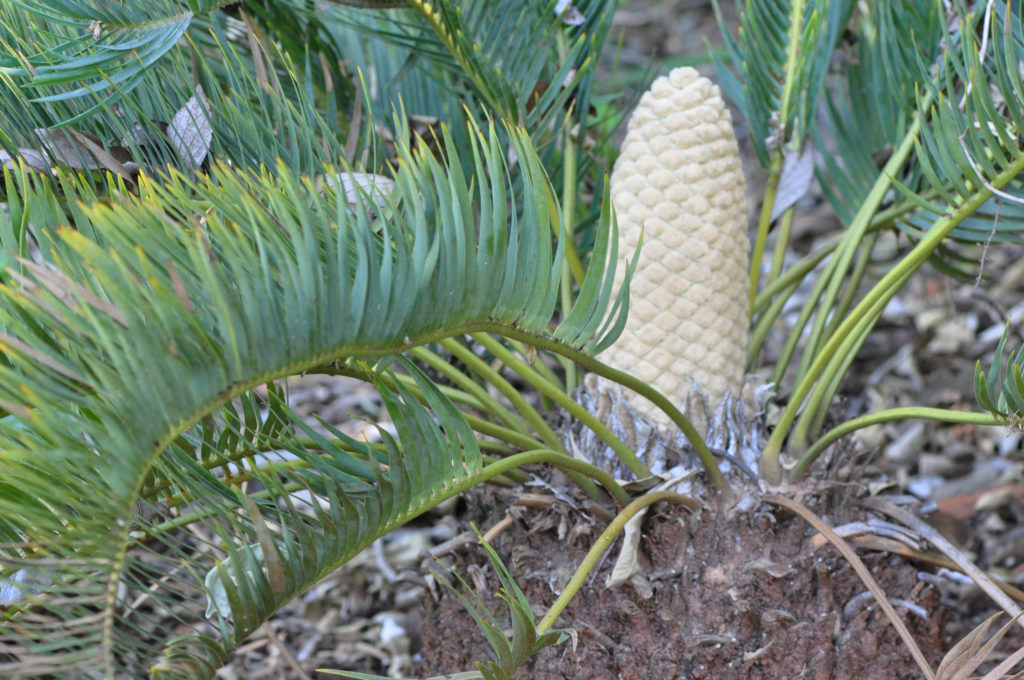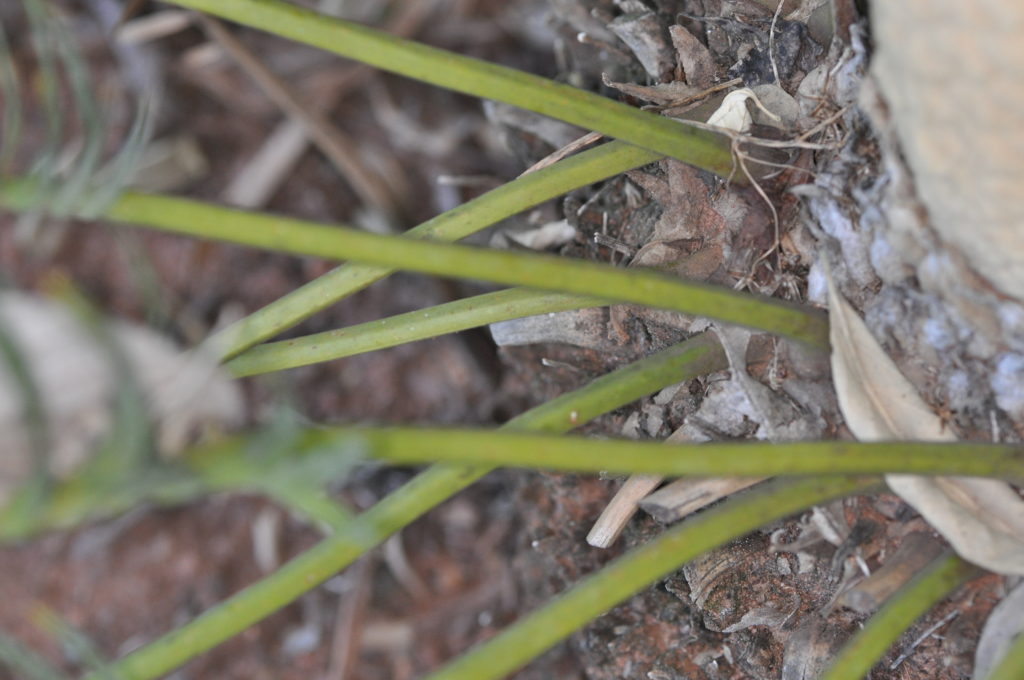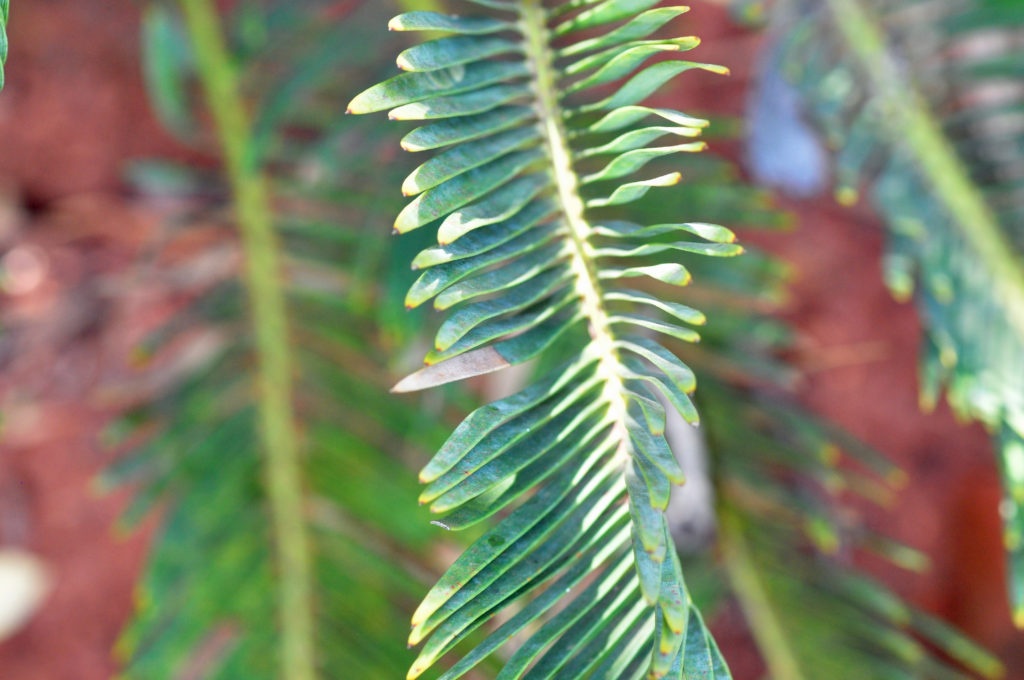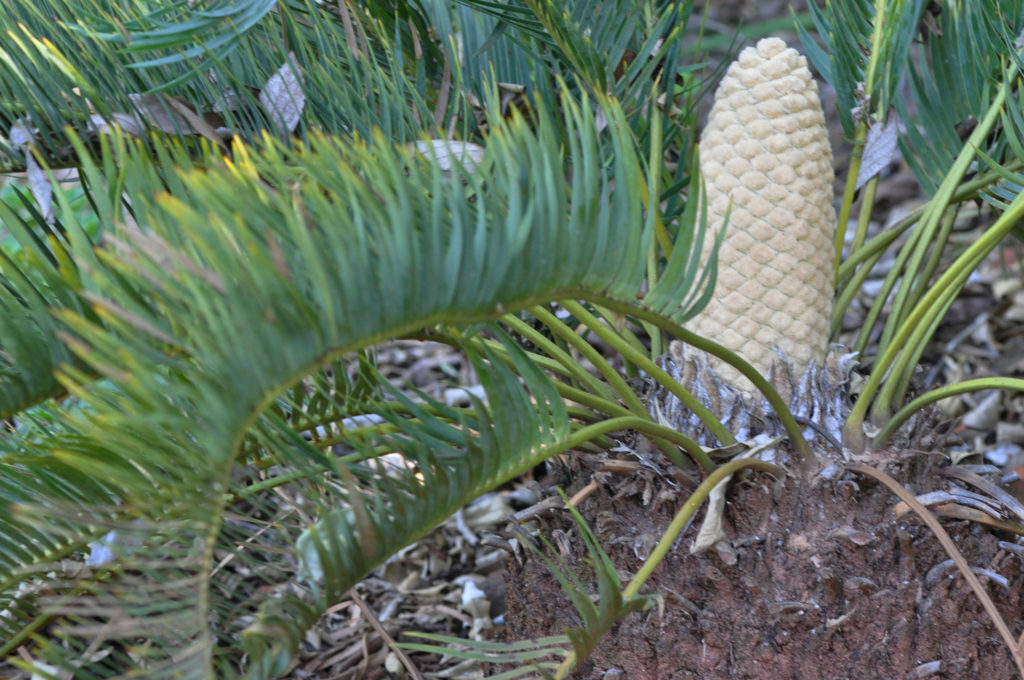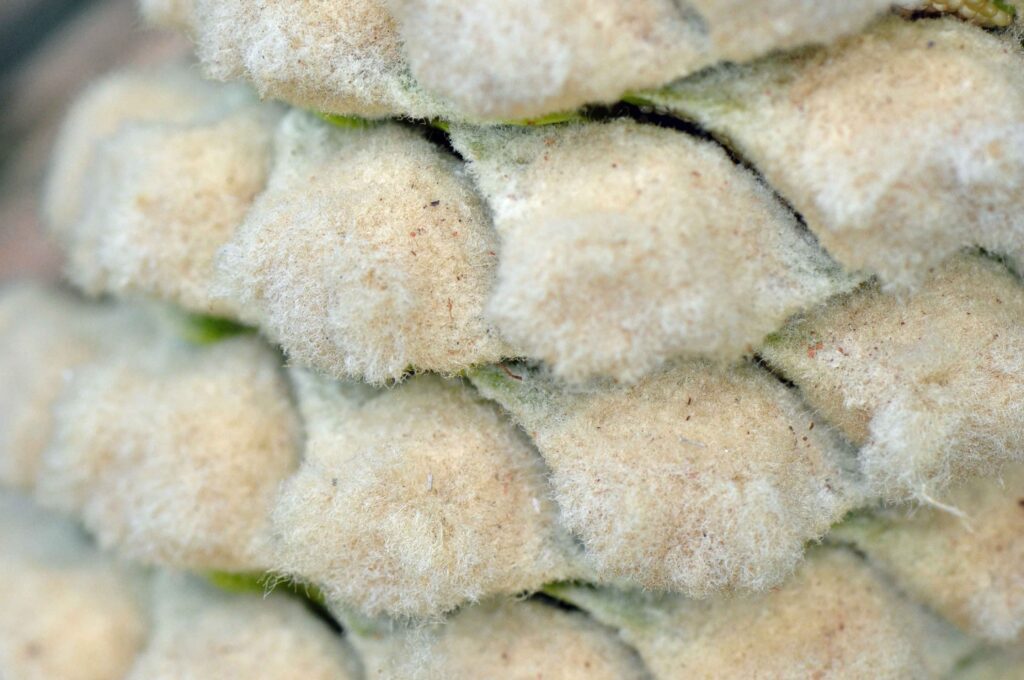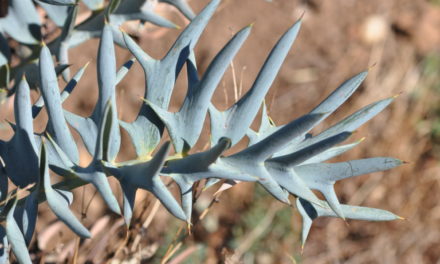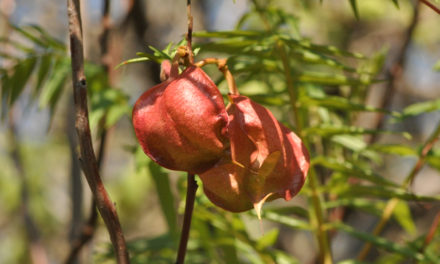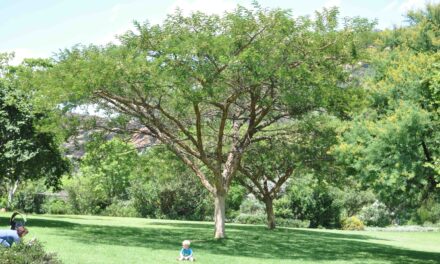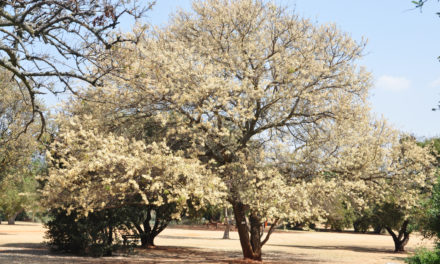General Info – summary
This dioecious, up to 2m high Tree may have more than 1 stem. Pinnately compound Leaves have non-overlapping, parallel veined leaflets and entire margins. Lowermost leaflets are not reduced to prickles. Cylindrical woolly Male Cones are reddish, and the large, cream-yellow barrel-shaped Female Cones are hairy. Both types of cones rest on a short stalk. Seeds, with a yellowish sarcotesta, are poisonous.
Description
Encephalartos lanatus
SA Tree No. 5.2.
Common names: (Afr) Olifantsrivier-broodboom. (Eng) Olifants River Cycad. (Northern Sotho) Mofaka. (siSwati) Sijekwane.
Family: Zamiaceae. This family is part of the major group: Gymnosperms. Zamiaceae are usually cone-bearing plants producing naked seeds and include Ginkgo (in China), Cycads, Conifers (e.g., pine trees) and Gnetophytes: e.g., the unique Welwitschia mirabilis (tweeblaarkanniedood) are not wind pollinated and found in the deserts of western Namibia and southern Angola. Members of the gymnosperm family Zamiaceae have no flowers or fruit and the seeds are often contained in Cones. Unlike other members of the family Zamiaceae, the cycads have leaflets that lack a central Midrib (vein). This family has 8 genera, including the Genus Encephalartos, which contains all species (about 66) of cycads and 35+ of these occur in southern Africa.
Name derivation: Encephalartos – within-head-bread: referring to the starchy bread that can be made from the pith of the inner trunk. lanatus Latin for woolly – between leaf bases the stem is very woolly as are the female cones. All cycads fall into the genus Encephalartos, which includes some of the most primitive living Gymnosperms. All species of cycads produce Sperm, which do not move along a pollen tube. Species of Encephalartos (Cycads) are only superficially palm or fern like and are usually unbranched.
Conservation: National Assessment Status: Near Threatened. Assessment Date: 2009. (J.S. Donaldson).
Tree
The Stem is usually less than 2m high and up to 30cm wide. Veld fires often blacken the stem. More than 1 Stem (main axis of the plant) may be present. Only leaf scars remain on the trunk once the entire leaves fall. In (photo 2 under Leaves) the remains of petioles that have not yet fallen are visible. The crown is woolly between leaf bases – hence the specific name. The many persistent, woody leaf scars provide much of the structural support for the trunk. These surround the stem. Suckers may be present. The cycad Tap Root is usually soon replaced by lateral roots, which become woody.
- 1. Photo: David Becking.
Leaves
Cycads are unique Gymnosperms with pinnately compound Leaves (here the leaflets are arranged along either side of the leaf rachis, the central stalk, like a feather). These leaves are up to 90cm long and tend to curve backwards. Young leaves are silvery and hairy. Mature Leaflets do not bend easily and are set in a tight V-formation – along the greenish, entire Rachis (here the extension of the petiole of the compound leaf that bears the leaflets). Leaflets are not lobed but do overlap (photo 3) and have visible veins on the lower, slightly lighter, surface. Initially leaflets have a bluish green powdery bloom that becomes green and bloom-free with time. Margins are entire (with a continuous margin, not in any way indented). The central leaflets are the largest – up to 140 x 8mm. From here, leaflet size decreases towards the apex and the Petiole (leaf stalk – which may reach 10cm long – photo 3). The lowermost leaflets are not reduced to spines. The middle leaflets have 10-14 parallel nerves (veins) visible on the lower surface. Stomata (structure utilising 2 guard cells that, unlike lenticels, can control gaseous exchange) may occur on both blade surfaces.
- 2. Photo: David Becking.
- 3. Photo: David Becking.
Cones
The cones develop in the centre of the terminal leaf whorls. These initially creamy yellow Cones change to grey and are usually produced on an annual basis. They are initially covered with a persistent hairy layer giving the colour. The plant is dioecious (having male and female cones on different plants). The Male cones are reddish, woolly, cylindrical but much narrower and slightly shorter than the female cones. Each cone is up to 30 x 6cm. The barrel shaped Female cones are densely woolly and up to 4 are produced. Each is up to 35 x 15cm. They are situated on a stalk that is up to 2cm long. Seeds are up to 3 x 2,5cm and have a yellow fleshy testa (this type of fleshy seed coat is called a sarcotesta).
Gymnosperms have unenclosed or naked seeds. They have no flowers or fruit, and the seeds are often contained in cones. In the Angiosperms (flowering plants), the seeds are enclosed in an ovary. In the Gymnosperms, there are 2 modes of fertilization. In all the Cycads (including Encephalartos) and the single extant (not extinct) species Ginkgo biloba, the male cones produce motile sperms. Whereas the remaining members of the Gymnosperms all have non-motile sperm with no flagella and are moved along with a pollen tube to the egg. At maturity, Seeds are released when the Female cones disintegrate.
- 5. Photo: David Becking.
- 6. Photo: David Becking.
Distribution & Ecology
This cycad is slow growing and is a South African Endemic (Endemism is the ecological state of a species being unique to a defined geographic location). Plants occur on sandstone slopes and in sheltered valleys – mainly in the catchment area of the Olifants and Wilge Rivers. The former river starts near Bethal – (about 150km east of Johannesburg in Mpumalanga) and Breyten which is the highest point on the watershed between the westward flowing Vaal River system draining into the Atlantic Ocean and the eastward flowing Olifants and Komati River systems which drains into the Indian Ocean after flowing through Mozambique. Trees are found in deep sandy soil, often in grassland where annual rainfall is in the region of 660-770mm. They occur naturally in Gauteng and Mpumalanga to the East of eMalahleni (Witbank). Altitude range is 1 200m – 1 800m. This Cycad is fire and frost resistant and dark stem colour may reflect the passage of fire. There are only 2 known insects that feed exclusively on the cycad gametophyte. One of these is the very long-snouted weevil, Antliarhinus zamiae, which lays its eggs inside the cycad seeds and the hatched larvae devour the seeds. The effect on the tree can be devastating. Cycads have Coralloid Roots that contain symbiotic cyanobacteria (blue-green algae) that fix atmospheric nitrogen. Through a process of complex biological pathways, the cyanobacteria convert atmospheric molecular nitrogen into compounds such as ammonia, and amino acids needed by the cycads.
Ethnobotany
This slow growing plant is drought resistant and frost hardy. It does best with summer rainfall and in moderately sunny positions. The distinction between this plant and that of E. humillis, E. friderici-guilielmi and E. lavifolius is small. It is distinguished from the lattermost by having keeled leaves which end in recurved tips. E. lanatus also has a densely woolly crown. The best means of propagation is by Seeds. It takes a few years to distinguish male from female seedlings and both trees are required for seed production. Survival of transplanted plants is very poor. Note: these seeds are poisonous. All seeds produce carcinogenic and neurotoxic glycosides (cycasins). These seeds are poisonous to mammals – including man. Toxic compounds in plants generally serve as a defence mechanism and may have had an important role in Cycad survival over their long evolutionary history. Take appropriate care when handling seeds (wear gloves) and do not eat them. Toxins involved may affect the liver and increase cancer risk.
References
Coates Palgrave, M. 2002. Keith Coates Palgrave Trees of Southern Africa. edn 3. Struik, Cape Town.
Donaldson, J.S. 2009. Encephalartos lanatus Stapf & Burtt Davy. National Assessment: Red List of South African Plants version 2020.1. Accessed on 2023/04/08
Lawrence, G. H. M, 1951. Taxonomy of Vascular Plants. The Macmillan Company, New York. Tenth Printing 1965.
Palmer, E. & Pitman, N. 1972. Trees of southern Africa. Balkema, Amsterdam, Cape Town.
Schmidt, S. Lotter, M. & McCleland, W. 2002. Trees and Shrubs of Mpumalanga and the Kruger National Park.
http://onlinelibrary.wiley.com/doi/10.1111/j.1095-8312.1992.tb00653.x/abstract
http://researchspace.ukzn.ac.za/bitstream/handle/10413/5402/Nair_James_Jerald_1990.pdf;sequence=1
http://plantnet.rbgsyd.nsw.gov.au/cgi-bin/cycadpg?taxname=Encephalartos+lanatus
http://www.succulent-plant.com/families/cycadaceae.html
http://biodiversityadvisor.sanbi.org/wp-content/uploads/sanbi-identify-it/plants/encephalartos.htm
http://www.theplantlist.org/browse/G/Zamiaceae/
https://www.diffen.com/difference/Angiosperms_vs_Gymnosperms


